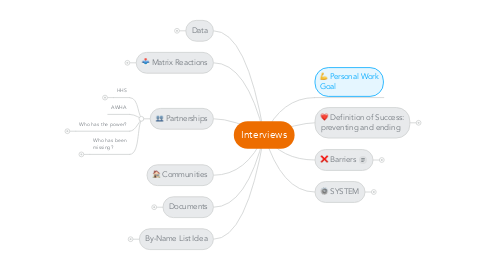
1. Personal Work Goal
2. Definition of Success: preventing and ending
2.1. It's possible: because of veteran success
2.1.1. vets doesn't equal youth
2.1.1.1. developmentally
2.1.1.2. different trauma
3. Barriers
3.1. no reasonable marker to gauge progress, level of resources, document need; PIT count is not sensitive to youth population (behave differently, inherent nature of being 14-24); numbers don't accurately/appropriately capture youth
3.1.1. don't know how many there are
3.1.2. don't know where to intervene
3.1.3. implications of no data - wrong resources
3.1.4. can't think beyond this at this time - literature review but still thin; mental health literature to see what works (and this could probably be provided
3.2. resources - no gauge
3.2.1. anecdotal suggest that there is a larger need; but no strong foundation
3.2.2. state and local resources are probably be used (Opportunity to learn here)
3.2.2.1. so what are the drivers? local? or federal pieces? or a combo? so where do you intervene?
4. SYSTEM
4.1. different categories of youth and therefore not one door, and addresses different needs;
4.1.1. Child Welfare
4.1.1.1. entitled - different door
4.1.1.2. 50 different systems bc at state level; state allocates it
4.1.1.2.1. 11 states: individual counties run things
4.1.1.2.2. no competition - it's formula
4.1.2. RHY
4.1.2.1. Shelter: 21 days
4.1.2.1.1. not entitled
4.1.2.1.2. federal gov't RHY allocates grants directly to non-profits through competition
4.1.2.2. outreach: hygiene kit and trying to build trust
4.1.2.3. Transitional Living: 18 months
4.1.2.3.1. apts
4.1.2.3.2. group homes
4.1.3. Other systems
4.1.3.1. ES from different funding streams for all populations (Adults)
4.2. Different populations but overlap
4.2.1. youth who aged out of FC
4.2.2. in foster care, returned home, ran away
4.2.3. run away from FC
4.2.4. JJ system and run away, or released, placed in group home and ran away,
4.2.5. LGBTQ - more systematic understanding of what the number is
4.2.6. youth parents
4.2.6.1. or with families
4.2.7. unaccompanied youth
4.2.8. minorities - african american/native american
4.3. prevention vs. shortening vs. recurrance
4.4. ASSESSMENT: who's on the path to be chronic vs. go home quickly (just needed little outlet/intervention)
4.4.1. RHY = 60% go home
5. Data
5.1. Reduce Occurance
5.2. Shorten Episode
5.3. Minimize Recurrence
5.4. Chapin's overarching Research questions that they want to answer: putting together the tool and instruments to allow for analysis that will then allow you to say something
5.4.1. how many
5.4.2. what's the experience been
5.4.3. what works
6. Matrix Reactions
6.1. success at capturing?
6.2. sub-populations
6.3. tweaks
6.3.1. recommendation #1
6.4. priority areas
7. Partnerships
7.1. HHS
7.1.1. FYS bureau
7.1.1.1. Sonali Patel used to work there
7.2. AWHA
7.3. Who has the power?
7.3.1. maybe is it missing all around; not a field with alot of power
7.3.2. fractured way that services get funded, spend so much energy to just cobble together funding
7.3.2.1. structure to "fend for yourself" / mirrors the youth that they serve
7.4. Who has been missing?
7.4.1. Maybe local folks from Dept of Ed and Justice
7.4.2. mental health professionals who might stop at RHY population
7.4.3. Business community
7.4.4. Congressional level staffers who champion RHY (not the case for child welfare); maybe local and state legislators
8. Communities
9. Documents
9.1. USICH framework
9.1.1. Sonali Patel was involved in 2010
10. By-Name List Idea
10.1. Concerns:
10.1.1. low level of trust for anything that is authoriative
10.1.2. Tough because they are minors
10.2. Helps with de-duplications
10.2.1. currently counts number of hygiene kits, but doesn't de-duplicate
